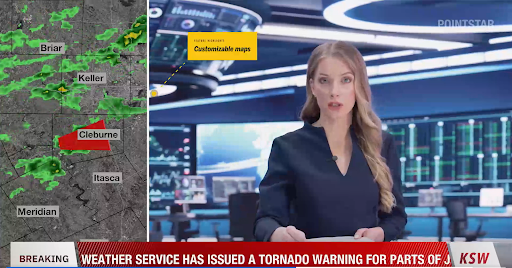Weather intelligence for the future: Crafting a strategic enterprise approach to changing environmental conditions
Continue readingViewers are increasingly interested in personalized content across mediums, and weather broadcasting is no exception. This growing demand is transforming how meteorological information needs to be delivered — and weather broadcasters need to answer the call.
By meeting viewers’ expectations for tailored information, weather broadcasters can increase engagement, trust, and reliance among their audiences, ensuring that the forecasts they provide are integral to each viewer’s planning of their day.
What is a custom weather forecast?
A custom weather forecast provides tailored meteorological information specific to an individual’s or business’s location and needs, rather than a broad, generalized forecast covering a large area. These forecasts typically focus on a particular city, town, or even a ZIP Code, providing detailed and relevant weather data that is immediately applicable to the viewer’s current surroundings. They also utilize advanced data modeling and meteorological technology to predict weather changes with high precision.
What are the advantages of custom weather forecasts?
Custom weather forecasts are revolutionizing how viewers interact with meteorological data, offering substantial advantages that extend beyond the basic provision of weather information.
1. Meeting demand
Viewers increasingly demand forecasts that cater specifically to their local environments. SmithGeiger research shows that 63% of viewers prefer forecasts targeted to their geographic areas, and 69% desire predictions narrowed down to their ZIP Codes. This high demand underscores the need for precision in meteorological services.
2. Improving trust
Personalized weather forecasts cater to specific viewer needs while also building trust. Viewers tend to rely more on forecasts that address their local weather conditions directly, enhancing their trust in your brand and ensuring consistent viewer engagement.
3. Increasing relevance
General forecasts often include details that may not apply to all areas covered, leading to viewer dissatisfaction. For example, a meteorologist may say it will be rainy tomorrow, but only one part of your city or town ends up wet. By focusing on relevant information, you can ensure that your content is of direct interest to your audience, thereby increasing viewer retention.
4. Helping viewers plan their day
Detailed, localized forecasts allow viewers to plan their activities with greater confidence, knowing how weather will affect their specific location throughout the day. This personalization addresses another common viewer grievance: the lack of specific timing for predicted weather changes.
5. Improving weather forecast accuracy
Custom weather forecasts significantly enhance accuracy by tailoring predictions to specific local conditions. By focusing on the unique aspects of each locality, custom forecasts provide more relevant and actionable information, thereby improving overall forecast accuracy. This is one of the reasons why The Weather Company is the world’s most accurate weather forecaster overall, according to a 2017-2022 study from ForecastWatch: Global and Regional Weather Forecast Accuracy Overview, 2017-2022, commissioned by The Weather Company. The Weather Company leverages localized data to ensure reliable predictions. This approach is crucial for viewers who depend on accurate weather forecasts for personal planning and safety.
Where can personalized weather forecasts show up?
Personalized weather forecasts have risen in popularity in recent years, becoming ubiquitous in a wide variety of mediums. Here’s just a few places where you may have noticed them:
Linear TV
Linear TV, the traditional model for television broadcasting, utilizes some localization for broadcasts through weather alerts. Because weather updates are scheduled at specific times, you can ensure that your viewers receive timely information tailored to their local area. This format is particularly used during weather emergencies or sudden changes, allowing you to interrupt regular programming to provide critical updates. With Max Alert Live, broadcasters can add a detailed map to their crawl down to the DMA level, so viewers can fully understand the impacted area. See example below.

CTV platforms
Connected TV (CTV) platforms turn regular TVs into smart TVs, allowing users to access a wide range of online services, including personalized weather content. According to SmithGeiger research, demand on CTV platforms is growing, with 21% of viewers wanting an on-demand customized forecast on a weather streaming service through these platforms. Through channels specifically designed for weather tracking, viewers can receive real-time updates, alerts, and detailed forecasts directly on their television screens for their precise location.
Mobile devices
Mobile devices are increasingly becoming a preferred platform for accessing personalized weather information, with 80% of viewers favoring mobile platforms for their weather updates according to SmithGeiger research. These devices offer unparalleled convenience and immediacy. Users can receive tailored forecasts that are specific to their exact location thanks to GPS technology, which enhances the relevance and accuracy of the information provided.
Out of home
The demand for accessible weather information while on the move is high, with SmithGeiger research finding that 49% of viewers value forecasts at airports, 42% on airplanes, and 34% at train or bus stops. These forecasts are crucial for travelers making informed decisions about the potential for travel delays, which activities to plan for a trip, and appropriate clothing to pack.
What to consider when building custom weather forecasts
When developing custom weather forecasts, it’s crucial to consider a variety of factors that directly impact their effectiveness and relevance for the intended audience. Understanding the nuances of custom weather forecasts will help you deliver the right messaging and information to your viewers every time.
Viewer location
Customizing forecasts at a hyperlocal level is key. Whether you’re targeting a city, town, or even a specific ZIP Code, detailed localization will ensure that each viewer receives information that’s relevant to their specific location.
Time of day
Providing hour-by-hour breakdowns, and in the case of severe weather, minute-by-minute updates, can significantly enhance the utility of a forecast. This detailed temporal resolution helps individuals and businesses make more informed decisions about their daily activities, particularly when planning weather-sensitive events or tasks.
Day of the week
Weekly forecasts help viewers plan their week ahead, especially when they include varied weather conditions expected over seven days. Offering a comprehensive seven-day forecast and highlighting their weekend forecast helps viewers plan their week more effectively.
Forecasted weather
Integrating predictive radar images, especially when rain or severe weather is anticipated, can improve the forecast’s usefulness. This visual tool helps viewers better understand the weather that may impact their area.
Severe weather
Providing timely and location-specific severe weather alerts is crucial for safety and preparedness. These alerts should be based on real-time weather data to ensure they are as accurate and relevant as possible.
Lifestyle and health forecasts
Including information on seasonal conditions makes weather forecasts more engaging and useful, particularly for viewers who regularly participate in outdoor activities. According to SmithGeiger research, 42% of viewers would like to see a day planner that lets them know how to plan outdoor activities. By incorporating detailed reports on pollen levels, humidity, and wind speeds, forecasts become comprehensive guides that help viewers manage their health and outdoor plans effectively. A golf, beach, or even running forecast are examples of other personalized weather content that can be delivered.
Develop personalized weather forecasts with ReelSphere
ReelSphere, from The Weather Company, offers a sophisticated platform to develop and broadcast personalized weather forecast videos across various channels. Leveraging AI and advanced meteorological tools, ReelSphere allows you to create detailed, engaging, and highly customized weather reels that meet the dynamic needs of today’s viewers.
By focusing on these detailed and specific forecasting needs, viewers receive tailored, timely forecasts. Learn more about how ReelSphere is opening up new possibilities for weather forecast personalization.
Let's talk
To learn more about automated, digital weather streaming content with ReelSphere, contact our media experts today.
Contact us


